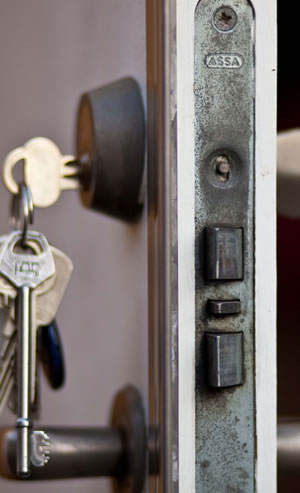The Safer Campus
Locking the Doors
- By Mark J. Berger
- 07/01/13

PHOTO COURTESY OF HÅKAN DAHLSTRÖM
Airports, hospitals, colleges and universities… all originally designed as open environments. Think of those wonderful movies where, at the last moment, the hero gets to the gate just in the nick of time to confess his love and stop the girl from getting on the plane. Today, the hero wouldn’t get past the first security checkpoint, never mind the body scanner.
We certainly can’t subject colleges and universities to the same level of restricted access as today’s airports, but there are new realities that change the way we look at creating a safe environment for students, faculty and staff.
THE STARTING POINT
Restricting access to residence halls has probably been the first wide-scale effort at addressing student safety. For buildings without 24-hour manned entrances, access control systems with cards, key fobs or integrated student IDs have become the norm. This “fortress-type” locking scenario concentrates on the perimeter while respecting life-safety codes. All exit-only doors must remain secured during the day, with alarms being used either each time the door is open, or “door prop” alarms used if they remain open for extended periods.
But residence halls are only a small part of the facilities in need of attention. Today’s emerging life-safety and security needs mandate that we think about all the other structures on campus in a new light.
Access control systems may be used to restrict after-hours access to certain buildings, but they are impractical for use during the day in the majority of facilities. Impeding the flow of students and faculty into the typical building throughout the day would create chaos. This might be acceptable at libraries and certain laboratories, but inefficient in halls with multiple classrooms and auditoriums.
The greatest philosophical change to locking must occur in how we change the locked status of our doors in response to an event. The speed with which emergency events now unfold are different than reacting to a natural disaster such as an earthquake, or a man-made emergency like a fire. We now have to consider how we “shelter in place,” not only for severe windstorms, but also for violent shooting events, as has befallen several campuses.
RETHINKING DOOR LOCKS
Sheltering in place requires us to rethink the function of door locks. Previously they had been used either to lock a facility, classroom or lab at the end of the day, or to restrict access to tardy students once a class had begun. Opening the door and turning a key in a lock, which disabled the exterior lever or knob, could accomplish both of these functions. Typical classroom doors are secured only by a latch, so enabling or disabling the exterior lever or knob functions as locking the door. Today’s new locking paradigm forces us to rethink our basic assumptions.
- Do we need to secure perimeters of buildings quickly and without a presence at the door?
- Can classroom doors remain in the open position while classes are underway?
- Do we need a communication system to be able to transmit the need to lock the doors in an emergency?
- Is local control of the door (the ability for anyone to lock a classroom from within) acceptable in terms of personal safety?
All of these must be considered in developing solutions, along with relevant life-safety codes which uniformly require single-motion egress from within the classroom at all times. Any solution that impedes single-motion exiting should not be considered — it is a life-safety hazard and must not be employed.
Security professionals are developing a variety of mechanical and electronic locking solutions to meet these quick-locking needs. Determining which solution meets the requirements for your campus facilities requires all stakeholders to review the various options, determine which best suits their needs and evaluate them while recognizing the new security paradigm for students, faculty and all those present on our campuses. There is no one-size-fits-all solution, and different buildings within a campus may require varied locking methods to enhance safety.
The task is daunting and requires a professional approach, one that addresses all the available technology to develop a cost-effective yet comprehensive solution. There are industry professionals developing “Best Practices” white papers, such as the ASIS Physical Security Council or School Safety & Security Council, which can aid you in your effort. Feel free to contact me at mberger@securitech.com and I will refer you to the appropriate contact.
This article originally appeared in the College Planning & Management July 2013 issue of Spaces4Learning.
About the Author
Mark J. Berger is the president & chief product officer for Securitech Group, Inc. and chair of the Builders Hardware Manufacturers Association Codes & Government Affairs Committee.